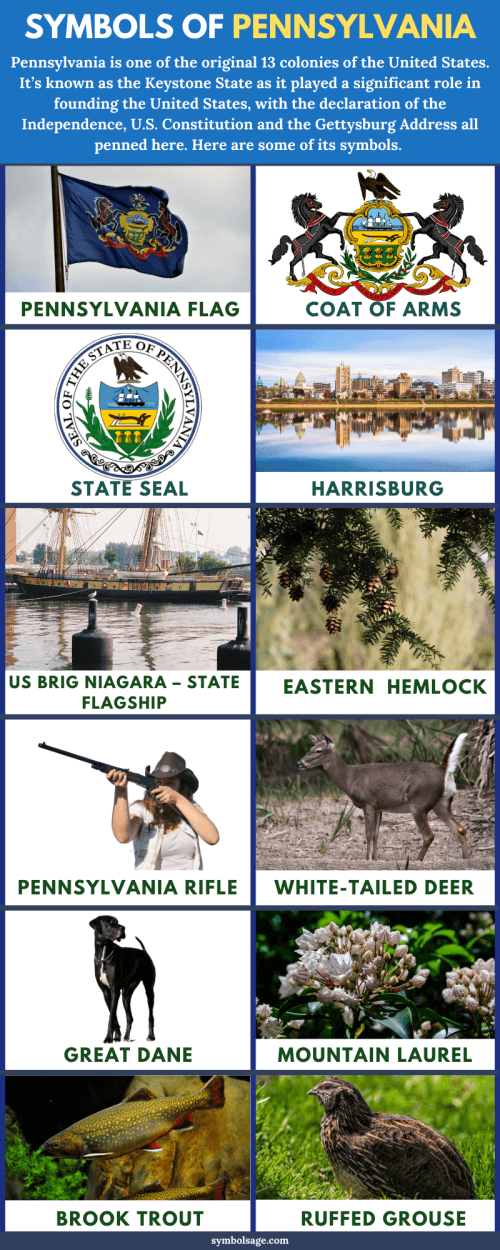
Table of Contents
Pennsylvania is one of the original 13 colonies of the United States, with a colonial history that dates back to 1681. It’s known as the Keystone State as it played a significant role in founding the United States, with the Declaration of Independence, U.S. Constitution and the Gettysburg Address all written here. Named after its co-founder, William Penn, Pennsylvania is the 33rd largest state in terms of area and also one of the most densely populated. Here’s a look at some of the official and unofficial symbols that represent this important state.

The Flag of Pennsylvania
The Flag of the State of Pennsylvania consists of a blue field on which is depicted the coat of arms of the state. The blue color of the flag is the same as that featured on the flag of the United States to symbolize the state’s bond with the other states. The current design of the flag was adopted by the state in 1907.
Coat of Arms of Pennsylvania
The Pennsylvanian Coat of Arms features a shield in the center, crested by an American bald eagle which represents the State’s loyalty to the U.S. The shield, flanked by two black horses, is adorned with a ship (representing commerce), a clay plough (symbolizing rich natural resources) and three sheaves of golden wheat (fertile fields). Under the shield is a cornstalk and an olive branch, symbolizing prosperity and peace. Below these is a ribbon with the state motto on it: ‘Virtue, Liberty and Independence’.
The current coat of arms was adopted in June 1907 and appears on important documents and publications throughout the state of Pennsylvania. It’s also displayed on the state flag.
Morris Arboretum
The Morris Arboretum of the University of Pennsylvania is home to over 13,000 plants of more than 2,500 types including conifers, magnolia, azaleas, hollies, roses, maples and witch hazels. It was previously the estate of siblings John T. Morris, who had a passion for growing plants from different countries and his sister Lydia T. Morris. When Lydia died in 1933, the estate was turned into a public arboretum which became the official arboretum of Pennsylvania. Today, it’s one of the most important landmarks in Philadelphia, attracting over 130,000 tourists each year.
Harrisburg – State Capital
Harrisburg, the capital city of the Commonwealth of Pennsylvania, is the third largest city with a population of 49,271. The city played an important role in the history of the U.S. during the Civil War, the Industrial Revolution and the Westward Migration. During the 19th century, the Pennsylvania Canal and later on the Pennsylvania Railroad were built, making it one of the most industrialized cities in the U.S. In 2010, Harrisburg was rated by Forbes as the second-best state to raise a family in the United States of America.
US Brig Niagara – State Flagship
The US Brig Niagara is the official Flagship of the Commonwealth of Pennsylvania, adopted in 1988. It was the flagship of Commodore Oliver Hazard Perry and played a crucial role in the Battle of Lake Eerie, the naval battle fought by the US Navy and the British Royal Navy. The ship is now an ambassador of Eerie and Pennsylvania, docked behind the Maritime Museum of Eerie. However, when not docked, she visits ports on the Atlantic Seaboard and the Great Lakes to give people the opportunity to be a part of this unique bit of history.
Motto: Virtue, Liberty and Independence
In 1875, the phrase ‘Virtue, Liberty and Independence’ officially became the state motto of Pennsylvania. Although it’s the motto of Pennsylvania, its meaning reflects the hope and attitude of the people of New York after the War of Independence during 1775-1783. The motto, designed by Caleb Lownes, first appeared on the coat of arms in 1778. Today, it’s a familiar sight serving on the state flag as well as on various official documents, letterheads and publications.
Seal of Pennsylvania
The official seal of Pennsylvania was authorized in 1791 by the state’s General Assembly and signifies authenticity which verifies commissions, proclamations and other official and legal papers of state. It’s different from most other state seals since it features both an obverse and a reverse. The image in the center of the seal is the state coat of arms without the horses on each side. It symbolizes Pennsylvania’s strengths: commerce, perseverance, labor and agriculture and also represents the state’s acknowledgement of its past and its hopes for the future.
Walnut Street Theater
The Walnut Street Theater was founded in 1809 and designated the Official Theater of the Commonwealth State of Pennsylvania. Located in Philadelphia on the corner of the street it was named after, the theater is 200 years old and considered the oldest in the U.S. The theater has undergone many renovations since it was opened with more parts added to it and existing structure repaired several times. It was the first theater to have gas footlights in 1837 and in 1855 it became the first to feature air conditioning. In 2008, the Walnut Street Theater celebrated its 200th year of live entertainment.
Eastern Hemlock
The eastern hemlock tree (Tsuga Canadensis) is a coniferous tree native to the eastern part of North America and was designated as the state tree of Pennsylvania. The eastern hemlock grows well in shade and can live over 500 years. The wood of the hemlock is soft and coarse with a light-buffed color, used for making crates as well as for general construction purposes. It’s also used as a source of paper pulp. In the past, American pioneers used the leafy twigs of the eastern hemlock to make tea and its branches for making brooms.
Pennsylvania Long Rifle
The long rifle, known by several names including the Pennsylvania Rifle, Kentucky Rifle or American Long Rifle, was among the first rifles that were commonly used for warfare and hunting. Characterized by its extremely long barrel, the rifle was popularized by German gunsmiths in America who brought with them the technology of rifling from its place of origin: Lancaster, Pennsylvania. The rifle’s accuracy made it an excellent tool for wildlife hunting in colonial America and it has been the state rifle of Commonwealth State of Pennsylvania since it was first created in the 1730s.
The White-Tailed Deer
Designated the state animal of Pennsylvania in 1959, the white-tailed deer plays a highly important role in nature and is admired for its grace and beauty. In the past, Native Americans relied on the white-tailed deer as a source of clothing, shelter and food as well as goods for the purpose of trading. Back then, the deer population was high in Pennsylvania with an estimated 8-10 deer every square mile. The deer gets its name from the white underside of its tail which waves when it runs and is flashed as a sign of danger.
The Great Dane
The official state dog of Pennsylvania since 1956, the Great Dane, was used in the past as a working and hunting breed. In fact, William Penn, the founder of Pennsylvania himself had a Great Dane which can be seen in a portrait that currently hangs in the Reception Room of the Pennsylvania Capitol. Called the ‘gentle giant’, the Great Dane is famous for its incredibly large size, friendly nature and need for physical affection from their owners. Danes are extremely tall dogs and the current record holder for the tallest dog in the world is a Dane named Freddy, who measured 40.7 inches.
Mountain Laurel
The state flower of Pennsylvania is the mountain laurel, an evergreen shrub belonging to the heather family native to the eastern US. The wood of the mountain laurel plant is strong and heavy but also extremely brittle. The plant has never been grown for commercial purposes since it doesn’t grow large enough. However, it’s often used for making bowls, wreaths, furniture and other household items. In the 19th century, it was also used for wood-work clocks. Although the mountain laurel is stunning in appearance, it’s poisonous to many animals as well as humans and ingesting it can eventually result in death.
The Brook Trout
The brook trout is a type of freshwater fish native to northeastern America and is the state fish of the Commonwealth of Pennsylvania. The color of the fish varies from dark green to brown and it has a unique marble pattern all over it, like spots. This fish inhabits small and large lakes, streams, rivers, spring ponds and creeks throughout Pennsylvania and needs clean water to live. While it can tolerate acidic waters, it doesn’t have the ability to handle temperatures over 65 degrees and will die in such conditions. Some say that the image of the brook trout symbolizes the knowledge of humans of the world and this knowledge is represented by the patterns on the back of the trout.
Ruffed Grouse
The ruffed grouse is a non-migratory bird, designated the state bird of Pennsylvania in 1931. With its strong, short wings, these birds have two unique morphs: brown and grey which are slightly different from each other. The bird has ruffs on both sides of its neck which is where it got its name from and it also has a crest on top of its head which sometimes lies flat and can’t be seen at first glance.
The grouse was a crucial source of food for the early settlers who depended on it for survival and found it easy to hunt. Today, however, its population is dwindling, and conservation projects are currently underway to prevent it from becoming extinct.
Check out our related articles on other popular state symbols:
Symbols of Hawaii
Symbols of California








